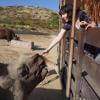The new WILDLABS platform gives our community the power to share content like case studies, articles, and blog posts directly with our global community, making it easier than ever to reach the right audience of your conservation tech peers.
Our community is full of brilliant ideas and knowledge worth writing about, and we want you to have the tools you need to get started creating your own content, no matter how much past experience you have with writing for a broad and diverse audience.
Because WILDLABS brings together members from every corner of the conservation tech field - beginners, experts, students, academics, field scientists, engineers, community scientists, and many more! - a case study, article, or blog shared through WILDLABS will find very different readers than something like a formal paper.
If you’re coming to us from an academic background, that means the way you share information with your new audience may feel different to you. Likewise, for some of our conservationists and tech experts, writing may be a skill you haven’t had much opportunity to hone yet. And if you’re someone who regularly blogs about your projects, expanding your audience through WILDLABS is a great opportunity to level up on your writing skills and the reach of your ideas!
Even the most experienced scientific writers can benefit from practicing basic techniques like considering what cross-section of an audience you’d like to speak to, and focusing on points that will connect with that audience most effectively.
If it’s your first time writing for WILDLABS or you need some extra advice to get started, check out the following tips, and check out the related articles at the bottom, where you'll find questions to consider while writing, along with a handy writing template!
For now, let’s get started with some tips on…
Choosing the Right Content Type for Your Story
Understanding what type of content you’re writing will help you craft something focused and impactful. To begin any type of content on WILDLABS, choose either "Article" or "Case Study" from our +Post button's menu - either will bring you to our content editor.

So what’s the difference between a case study, article, and blog post?
1. Case Studies
A recap of your completed project, or the work you’ve completed so far in an ongoing project. Case studies usually include specific information on tools used, any important techniques or processes involved in your work, and results or outcomes.
Case studies also include context that will help readers understand any technical aspects of your project. While a case study does not necessarily have to worry about teaching readers outside of the field about a topic, it should be written clearly enough that, with the right context and resources, a dedicated and interested reader without much knowledge in the topic could follow the basics. At the very least, they should leave your case study grasping the general importance of what you’re sharing.
While case studies may include similar information to a research paper, they are much shorter, and use less formal language and jargon than you’ll find in academia. A good way to think of a case study is “what I’d share with a group of students to summarize my project or research paper.”
This case study about 'Metal Detecting Sensors for Anti-Poaching' by Sam Seccombe is a great example of how to walk readers through the context and process of a project.
2. Articles
Articles can be research-based, opinion-based, or both! Like case studies, they can summarize research or a project, and provide context to readers.
Regardless of your previous experience writing for a science audience, you’ll definitely be familiar with the basics of articles since it’s the type of informative content you’ll encounter most in the world.
You’ve probably heard the basic questions of journalism before - Who? What? When? Where? Why? These questions are answered by most articles, even in opinion-based ones like “thought pieces.” Hitting these basic questions helps an article get readers up to speed quickly, and also provide important and necessary context in thought pieces.
Think of an article as a professional way to share news and summarize the most significant information about your work, but without the pressure of covering every step of your process or highly technical details - those details are better suited to case studies! Readers should leave an article with an understanding of your main points (regardless of their level of expertise!), but may have to look for more in-depth resources to understand the finer points of your work.
When it comes to thought pieces, keep in mind that while these types of articles are great for sharing opinions, those opinions should still be based in fact. Thought pieces are great for explaining why information matters or for making calls to action - not for general rants!
This Conservation International article on an app to fight the illegal shark fin trade, and this article by WILDLABS' Ellie Warren on a tracked sea turtle and the limitations of technology, are two examples of different styles of articles. The first has the primary goal of informing readers about a new tech tool, while the second informs while bringing in the author's opinions on the topic.
3. Blog Posts
This type of content has the most freedom, the loosest structure, and the most opportunity to share a unique story exactly the way you’d like to!
However, that doesn’t mean a blog post is a free-for-all - a great blog post is still clearly written, hits all of the main points of a story like an article would (Who? What? Where? When? Why?), and provides any context needed to help readers both understand and enjoy your story.
But a blog post allows you to infuse more of your own personality and experiences into your writing, get creative with things like photo essays or video diaries (vlogs), and talk about things like project updates more casually and with less pressure than writing an entire case study.
Importantly, blog posts can be great for reaching wide audiences because they don’t need to contain a lot of technical information or research. Likewise, they can also be great for reaching very small segments of our community because you can share a highly specific story that people with your same type of expertise will appreciate!
This post from BearID's blog about a trip into the field is a good example of how a blog post can show your personality, highlight stories about your project beyond technical details, and create interest in your work by talking directly to your readers.
Get Started Now!

Whatever story you want to tell to our community, and through whatever format, you can start sharing on WILDLABS now by using our +Post button in the top menu and selecting “Article” or "Case Study." (To share a blog post, select either of those options!)
Stay tuned for more writing tips throughout the week, as we cover the questions you can ask yourself while writing for our audience, and a template you can use to start sharing your stories and experiences on WILDLABS easily!
And if you'd like to get in touch with WILDLABS Editor Ellie Warren, drop into this Discussion thread to have a chat, brainstorm ideas, and get extra writing advice!






Add the first post in this thread.